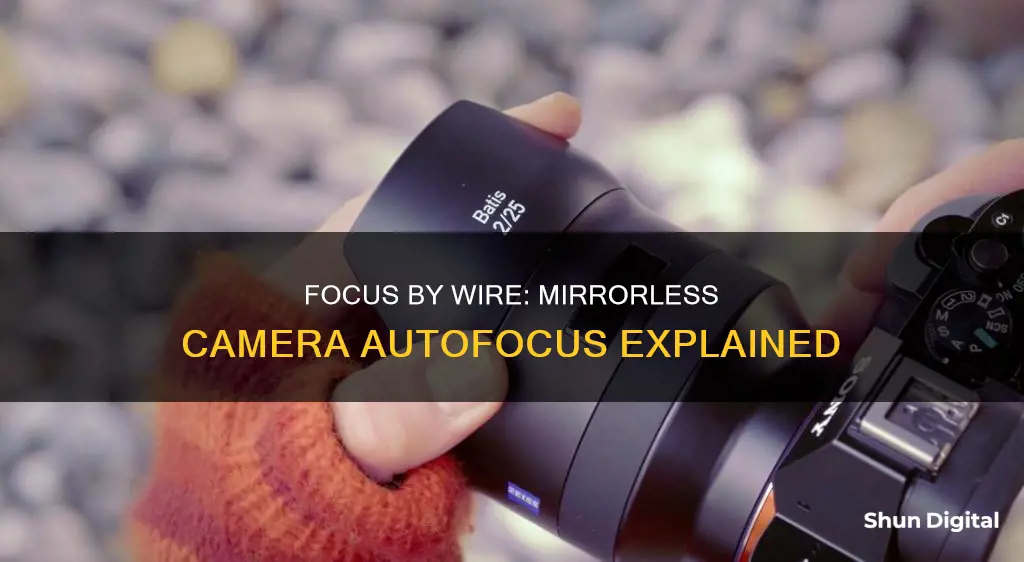
Focus by wire is a system found in many modern camera lenses, especially in mirrorless cameras. When using a focus by wire lens, turning the focus ring sends a signal to the camera motor, instructing it to move the lens elements. This is different from traditional lenses, where the focus ring directly moves the lens elements. While focus by wire allows for lighter and cheaper lenses, it can lead to inconsistent results when manually focusing, especially when shooting video.
| Characteristics | Values |
|---|---|
| Focus by wire system | Found in many camera lenses |
| Focus ring | Sends a signal to the camera motor to move the lens elements |
| Focus ring movement speed | Affects the accuracy of the focus point |
| Markings | Absent on mirrorless lenses |
| Techniques | Cannot use techniques like white tape on the lens with focus points marked |
| Consumer demand | Consumers want cheaper and lighter lenses |
| Manufacturers | Some manufacturers use hardware or software to address issues |
| Lens size | Focus by wire makes lenses smaller |
| Lens weight | Focus by wire makes lenses lighter |
| Lens design | Focus by wire allows the use of focus motor technologies |
| Lens compatibility | Lenses with focus by wire are not compatible with DSLR cameras |
What You'll Learn
- Focus by wire is inconsistent with where it focuses for a particular position on the focus ring
- Focus by wire makes it difficult to be consistent with your focusing work
- Focus by wire lenses have no markings, so you can't see the exact focusing distance
- Focus by wire lenses are cheaper and lighter
- Focus by wire lenses are smaller

Focus by wire is inconsistent with where it focuses for a particular position on the focus ring
"Focus by wire" is a system found in many modern camera lenses, including those on mirrorless cameras. It is a mechanism where turning the focus ring sends a signal to the camera motor, instructing it to move the lens elements. This is in contrast to traditional lenses, where the focus ring physically and directly moves the lens elements.
One of the main issues with focus by wire systems is their inconsistency in focusing on a particular point. This problem affects both video and still photographers. When adjusting the focus ring, the speed of the movement impacts the accuracy of the focus point. Slower movements result in more accurate focusing, while faster movements over the same distance can cause the lens to focus way off the intended target. This inconsistency makes it challenging for photographers and videographers to achieve consistent focus in their work.
The lack of markings on mirrorless lenses and the LCD screen's imprecise scale contribute to the difficulty in achieving precise focusing. The focus ring's position has "no relationship" to the actual focus point, rendering common techniques like using white tape with marked focus points ineffective. This issue is further exacerbated by the focus by wire system's consideration of the speed at which the ring is turned, making precise and repeatable focus pulls challenging.
The focus by wire system is favoured by manufacturers due to consumer demand for cheaper and lighter lenses. While it may meet these requirements, it comes at the cost of focusing precision and consistency. Some companies are attempting to address these issues through hardware and software solutions, such as Canon's CMOS hybrid dual-pixel AF, which allows users to touch areas on the screen to achieve smooth focus pulls.
Charging Olympus Camera Batteries: Where and How?
You may want to see also

Focus by wire makes it difficult to be consistent with your focusing work
"Focus by wire" is a system found in many modern camera lenses, including those on mirrorless cameras. It is an electrical manual focusing system, where the focus ring is not mechanically connected to the lens. Instead, turning the focus ring sends a signal to the camera motor, telling it how to move the lens elements.
This issue also affects stills photographers using manual focus. Mirrorless lenses have no markings, so you can't see the exact focusing distance. The LCD screen is also unhelpful, showing a vague scale. Common techniques like using white tape on the lens with focus points marked on it are useless with focus by wire, as the focus ring's position has "no relationship" to the actual focus point.
While focus by wire presents these challenges, it's important to note that consumers want cheaper and lighter lenses, and focus by wire adheres to this demand. Additionally, some companies are developing hardware and software solutions to address these issues. For example, Canon's CMOS hybrid dual-pixel AF allows users to touch areas on the screen to focus, enabling smooth focus pulls.
Polaroid Camera Battery Requirements: What You Need to Know
You may want to see also

Focus by wire lenses have no markings, so you can't see the exact focusing distance
"Focus by wire" is a system found in many modern camera lenses, including those used in mirrorless cameras. It allows the photographer to send a signal from the focus ring to the camera motor, telling it how to move the lens elements. This is in contrast to traditional lenses, where the focus ring physically moves the lens elements.
One of the drawbacks of focus-by-wire systems is that they often lack markings on the lens, making it difficult to determine the exact focusing distance. This can be problematic for photographers who rely on precision focusing, as the LCD screen often only displays a vague scale. Additionally, common techniques such as using white tape to mark focus points are ineffective with focus by wire lenses because the focus ring's position does not correspond directly to the focus point.
The lack of markings on focus-by-wire lenses can be frustrating for photographers who prefer manual focus or require precise focusing distances. However, it is important to note that some manufacturers are developing hardware and software solutions to improve the manual focusing experience on these lenses.
Charging Your Fujifilm Camera Battery: Alternative Methods
You may want to see also

Focus by wire lenses are cheaper and lighter
The "focus by wire" system in camera lenses is a polarising topic among photographers. This system is found in many camera lenses today, especially in mirrorless cameras. When you turn the focus ring on a mirrorless lens, you are sending a signal to the camera motor to move the lens elements, instead of moving those elements directly. This system is favoured by consumers because it makes lenses cheaper and lighter.
Focus by wire lenses also allow for the use of focus motor technologies that would not be possible with a mechanical focus system. For example, linear voice coil actuators (VCAs) can be used to move the focusing element of the lens rapidly and precisely. This type of technology is not compatible with mechanical focus couplings.
While some photographers prefer the feel of mechanical manual focusing, focus by wire lenses offer benefits such as increased sensitivity and fine-grained focus. In addition, focus by wire lenses are often more affordable and accessible, especially for those who are new to photography or are on a budget.
Overall, while focus by wire lenses may have some drawbacks, they offer advantages in terms of cost, weight, and compatibility with modern camera technologies.
Focusing Moto 4e Camera on Tiny Objects: Tips and Tricks
You may want to see also

Focus by wire lenses are smaller
"Focus by wire" is a system found in many modern camera lenses. When you turn the focus ring on a mirrorless lens, you are sending a signal to the camera motor, telling it to move the lens elements. This is different from a traditional focus ring, which moves the lens elements directly and physically.
Focus-by-wire lenses are smaller and lighter, which is a significant advantage for photographers who have to carry their equipment for long periods. This is also in line with consumer demands for more portable equipment.
The focus-by-wire system allows manufacturers to control the relationship between the focus ring and lens movement, enabling longer "throws." This feature is particularly useful for photographers who require precise control over their focus, such as those shooting in macro mode.
However, it is worth noting that some photographers dislike the feel and latency of an electronic system. The focus-by-wire system requires power to function, which means that manual focusing is not possible when the camera is switched off. Additionally, the speed of movement when shooting video can impact the accuracy of the focus.
Tennessee Speeding Camera Tickets: Do You Have to Pay?
You may want to see also







